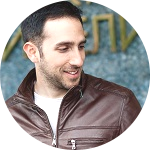At an opposition rally in Minsk on 16 August 2020, demonstrators hold signs that say: "Give me back my voice" and "Lukashenko out".
It is Monday 17 August 2020 and we are on the immense Nezavisimosti Avenue (Independence Avenue) that crosses the Belarusian capital when a gleaming sports car appears with a young couple waving the white-red-white flag. Dozens of students gathered on the roadside cheer in approval. Since the disputed presidential election, the former flag of the Belarusian People’s Republic (proclaimed in 1918), once only claimed by nationalist militants, has become a new symbol of opposition to Alexander Lukashenko.
Re-elected for the sixth consecutive time on 9 August 2020, Lukashenko has reigned unchallenged on the national political stage since 1994. His claimed victory with 80 per cent of the vote is still fiercely contested by a large part of the population, which accuses him of fraud (several investigations suggest the ballot was rigged, even in certain embassies). His main contender, Svetlana Tikhanovskaya, was only credited with 10 per cent of the vote, despite the enthusiasm around her candidacy. The result provoked a wave of impromptu demonstrations on a scale never before seen and which continue to be held, almost six weeks after the elections.
“The young people of this country have changed,” says Sasha Romanova, director of two private online news outlets, Kyky.org and The Village. “Many [young Belarusians] have now travelled, seen and experienced something else, especially in Lithuania, where they are regular visitors. They have embraced the lifestyle, the partying, the leisure time and share the same universal desires; there is no difference between what the young people of Belarus and what the young people of New York want.” According to official statistics, in 2018, about 15,000 people moved out of the country and almost half of them were between 20 and 35 years old.
Created in 2010, Kyky.org now receives around two million visits a month, according to the 38-year-old (The Village has one million). Financed by advertising revenue, it mainly deals with topics such as fashion, leisure, economic affairs or sexuality. Its editorial line is mainly aimed at an urban audience that its director describes as “refined and cultured”. It shares the media landscape with many other sites, such as Tut.by or the very popular Nexta. Founded in 2015 by Stepan Putilo (then 17 years old) and based in Poland, Nexta (“Someone” in Belarusian) is a Telegram channel that plays an active role in the coordination of demonstrations and the broadcasting of information hostile to the regime.
New technologies and digital media have become increasingly important in the lives of a generation that is now more influenced by the trends of a connected world than by Soviet traditions.
With almost 30 years having gone by since the fall of the USSR, virtually all those representing the opposition were born and grew up, for the most part, after that time. Sergei Tikhanovsky, who was replaced by his wife Svetlana after being barred from running in the presidential race, had made a name for himself through his internet activism as a vlogger.
According to Romanova, the reason these independent news media outlets are so popular with young people is because they are much more in tune with their interests. “We research social media to pick up on trends and topics of discussion so that we can provide articles that match demand, something state media don’t do.”
A more politicised young generation in an ageing country
A country with a population of about 9.5 million, Belarus has a rather low average fertility rate (1.5 children per woman according to Unicef figures for 2012), leading to negative population growth and population ageing. In January 2018, Tut.by identified the average Belarusian as “a 42 and a half year old woman with a high level of education” who “speaks Russian, votes for Lukashenko and eats 64 kilos of potatoes a year”. In 2019, 42 per cent of the population was aged under 35.
The quality of life in Belarus has improved substantially since 1991 when the former Soviet republic gained independence (it is now a high human development country, according to UNDP). Strong economic growth was achieved from 1995 until the financial and economic crisis struck in 2008 and growth became more uneven before slowing down in 2018. Over the same period, an educated urban youth has emerged, with enrolment rates in higher education of 87 per cent according to the 2018 United Nations Development Report.
A new category of high-income earners has also emerged, particularly in the tech industry, a population segment that has been very active in the recent protests. Valery Tsepkalo (now exiled in Russia) was the founder and director until 2007 of a high-tech park housing most of the companies that employ these young people. His wife, Veronika Tsepkalo, a former Microsoft executive, also emerged on the political scene in 2020 alongside the main opposition candidate Svetlana Tikhanovskaya.
“It is the children of the middle class that emerged out of the state apparatus who are now entering the political arena,” explains Bruno Drweski, a historian and lecturer at France’s INALCO research institute.
“Their parents, having experienced the USSR and the consequences of its dissolution combined with the fear of being absorbed by Russian oligarchs, had little choice but to support the ruling power at the time; but for them, this is all ancient history.” Most of them have only known Lukashenko as the country’s political leader. In the researcher’s view, the current wave of social protest is the result of generational renewal. “The regime, although not an all-out dictatorship, is archaic and paternalistic, young people aspire to a model closer to our Western societies, they want space to breathe.”
His observations are seconded by Romanova, who is “convinced that alternative media outlets have played a role in this shift”. They have promoted values identified with Western societies, such as consumerism, but also political and social liberties, such as freedom of expression. They have managed, as a result, to overtake the state media (television channels, newspapers) whose totally insipid format, stuck in the Soviet mould, has ceased to captivate a young generation that has grown up with the internet. This is particularly true of Minsk where, according to Drweski, “opposition to Lukashenko has a solid base, with around 45 per cent of the electorate from across the political spectrum”.
In addition to these underlying drivers, another trigger setting the protest machine in motion has been the indignation at the police repression of the largely peaceful post-election protests. Almost 7,000 demonstrators were arrested during the first week and at least four people were reportedly killed. “This has been the government’s big mistake,” says Drweski. “The result has been a tenfold increase in the number of people taking part in the demonstrations; it has even created shock among supporters of the regime, because repression has seldom been seen on this scale before, with just a handful of opponents being targeted until recently.” The Interior Ministry initially tried to take a placatory stance in response to the criticism surrounding the use of force, but several weeks later and there is still no end to the arrests of demonstrators and opponents, such as that of Maria Kolesnikova in early September. There has been no let-up in the crackdown and some have decided to leave the country. Among them is Sasha Romanova, who Equal Times met in August in Minsk and who spoke of a police raid on her home as a way of trying to clamp down on her activities and to sully her image amongst civil society.
Patriotic values
Not all Belarusian youngsters are lined up against the autocratic regime. Alexander Lebedev, a 19-year-old biology student, voted for Lukashenko. The young man, who lives in the country’s second largest city, Gomel, explains: “I voted for the president because he has brought us peace and stability. I also welcome the fact that our system provides easy access to education for all.” Once he finishes his studies, the scholarship student will have to complete a compulsory two-year work placement. This centralised system that has significantly contributed to slowing down the rural exodus by sending young graduates to work in the most remote and least appealing parts of the country.
The son of a military man and a housewife, Lebedev is an active member of the BRSM (the Belarusian Republican Youth Union). This organisation, founded in 2002 and modelled on the Komsomol (Communist Youth of the USSR), aims to provide a framework for youth activities (mainly sports and cultural) and to promote patriotic values. “We also organise voluntary work, such as helping veterans or taking part in maintenance activities on heritage sites,” explains the student. Widely considered as a pro-Lukashenko organisation, the BRSM has never succeeded in becoming a mass organisation, despite its initial ambitions. The young man knows that his choice of vote is not shared by all people his age:
“I even received a threat because I was supporting the president; I agree that people have a right to express their dissatisfaction with the results, but I condemn the violence.”
Since mid-August, the authorities have organised pro-government rallies across much of the country in response to the opposition’s daily public protest activities. These have forced both sides to argue and counter-argue their positions. Under pressure, Lukashenko has announced constitutional reform as a precondition for new elections. “This will undoubtedly politicise the country’s young population even more,” underlines Drweski. “They will have to discuss the model of society they want, talk about the economy and matters of consequence, we can even imagine that a large part of those who came out to protest will agree with the others on almost everything, except Lukashenko, who should not, in fact, be the real focus of division.”










